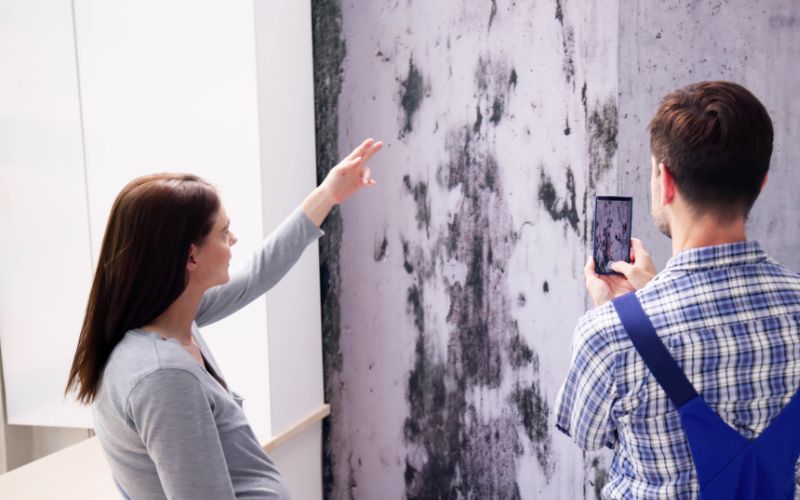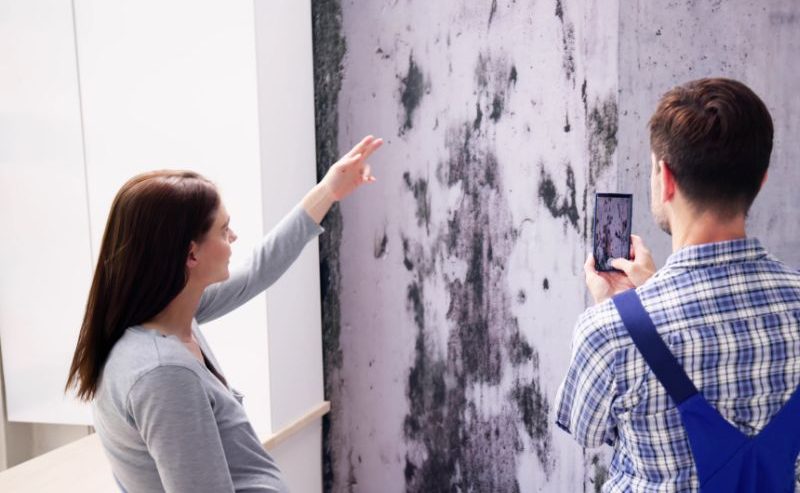
Image by AndreyPopov from Getty Images on Canva
If you’ve discovered black mold in your home, you’re probably wondering how to get rid of black mold safely and effectively. This type of mold is not only unsightly but also harmful to your health, especially if left unchecked. It thrives in damp, humid environments and can cause a range of health issues like respiratory problems and allergic reactions.
In this guide, we’ll walk you through practical methods to tackle black mold and prevent it from returning. While some minor mold problems can be handled with DIY solutions, more severe infestations require the expertise of professional mold remediation. Addressing the root cause of the mold, such as water damage, is key to ensuring your home stays mold-free in the future.
What Is Black Mold?
Black mold, or Stachybotrys chartarum, is a toxic type of fungus that thrives in damp, warm, and humid conditions. It typically grows on materials like wood, drywall, or carpets that have been exposed to water damage. Black mold appears as dark green or black patches and is known for producing mycotoxins, which can pose serious health risks. Exposure may cause respiratory issues, allergic reactions, or more severe health problems in sensitive individuals. Proper moisture control and prompt remediation are essential to prevent and eliminate black mold.
How to Get Rid of Black Mold Safely
There are several ways to address black mold, but professional help is crucial for severe infestations to ensure safety and thorough removal. For smaller cases, you can take effective steps yourself. Here, we’ll cover six safe methods to get rid of black mold and prevent its return.
1. Use a Commercial Mold Remover
Choose a commercial mold remover specifically designed to target black mold. These products contain powerful chemicals that effectively kill mold spores on contact. Always follow the manufacturer’s instructions for proper usage. Wear protective gloves, goggles, and a mask to avoid exposure to fumes or chemicals. Spray the remover directly onto the moldy surface, let it sit for the recommended time, and then scrub the area thoroughly. Rinse and dry the surface entirely to prevent mold regrowth. Proper ventilation is essential during and after the process.
2. Create a DIY Vinegar Solution
White vinegar is a natural and effective approach for black mold removal. Fill a spray bottle with undiluted vinegar and generously apply it to the affected area. Allow the vinegar to sit for at least an hour to infiltrate and kill the mold spores. Scrub the area with a brush to remove mold residue, and rinse with water. Dry the surface thoroughly to avoid moisture buildup, which can lead to regrowth. Vinegar’s non-toxic properties make it a safe option for households with children or pets.
3. Scrub with Baking Soda Paste
Baking soda is a gentle and non-toxic mold remover. Mix a paste using one part baking soda and one part water, then apply it directly to the moldy surface. Scrub the spot using a stiff brush to remove mold stains and spores. Rinse with water to clean the residue, and repeat if necessary. Baking soda not only removes mold but also absorbs moisture, helping to prevent future growth. This method is ideal for small mold problems on non-porous surfaces like tiles and glass.
4. Utilize Hydrogen Peroxide
Hydrogen peroxide is an affordable and effective mold-killing solution. Pour 3% hydrogen peroxide into a spray bottle and saturate the moldy area. Let it sit for 10 minutes to break down the mold spores. Scrub the area with a brush, then wipe it clean with a damp cloth. Ensure the surface is completely dry afterward to deter regrowth. Hydrogen peroxide is a safer option to bleach and works well on porous materials like wood or drywall, where mold tends to penetrate deeper.
5. Apply Tea Tree Oil Spray
Tea tree oil is a natural antifungal and antibacterial agent that works effectively against black mold. Blend one teaspoon of tea tree oil with one cup of water in a spray bottle. Shake well and lay the solution to the moldy area without rinsing it off, as the oil continues to fight spores after application. Wipe off any extra moisture with a clean cloth. Its natural properties make it a safe solution, but it should still be used with caution around pets.
6. Call Professional Mold Remediation Services
For extensive mold infestations, professional mold remediation is the safest solution. Experts have specialized tools and knowledge to recognize and completely eliminate mold from your home. They also address the root cause, such as water damage, to prevent recurrence. Professionals adhere to strict safety protocols to protect your health during the process. While this option can be more expensive, it ensures long-term results and peace of mind. Always choose licensed and reputable mold remediation companies for effective and reliable service.
Frequently Asked Questions

Image by 3dts from Getty Images Signature on Canva
Can black mold cause long-term health problems?
Yes, prolonged exposure to black mold can lead to long-term health issues, particularly in individuals with asthma, allergies, or compromised immune systems. Chronic exposure to mold can cause persistent respiratory problems, skin irritation, and headaches. If symptoms worsen over time, it’s crucial to seek medical attention and address the mold issue immediately.
How do I know if I have a black mold infestation?
Signs of black mold include visible dark patches or spots, a musty odor, and frequent health symptoms like coughing, sneezing, or skin irritation. Areas with excessive moisture, such as bathrooms, basements, or leaky pipes, are more susceptible to mold growth. If you notice these signs, it’s essential to act quickly to prevent further spread.
How to get rid of black mold in hard-to-reach areas?
To get rid of black mold in hard-to-reach areas, use a spray bottle to apply your mold removal solution (like vinegar or hydrogen peroxide). A long-handled brush or sponge can help scrub the affected area. For deep penetration, use a mold fogger for hard-to-reach spots. Always ensure proper ventilation and safety precautions.
How to get rid of black mold in your attic?
To get rid of black mold in your attic, first ensure proper ventilation and wear protective gear. Clean affected surfaces with a commercial mold remover or a DIY solution like vinegar or hydrogen peroxide. Fix any leaks and reduce moisture in the attic to prevent mold from returning. It’s essential to monitor humidity levels in the space.
Conclusion
Learning how to get rid of black mold is crucial for protecting your home and health. While DIY solutions can be effective for minor infestations, severe cases require professional mold remediation. Addressing the root cause, such as moisture issues, ensures long-term success in preventing mold growth.
If you’re dealing with black mold in your home, PuroClean Zephyrhills can help. Our professional mold remediation services ensure thorough removal and prevention. Contact us today for a safe, reliable solution to your mold problems.




 PuroClean Certified Restoration Specialists
PuroClean Certified Restoration Specialists